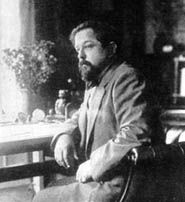| B i o g r a p h y |
 Achille-Claude Debussy
(1862-1918) is one of the most influential composers who creates a
unique and forward-looking style of innovative technical finish and
poetic appeal. His works significantly break away from the concepts of
traditional form and harmony. He is also considered the most important
composer of piano music since Frédéric Chopin.
Achille-Claude Debussy
(1862-1918) is one of the most influential composers who creates a
unique and forward-looking style of innovative technical finish and
poetic appeal. His works significantly break away from the concepts of
traditional form and harmony. He is also considered the most important
composer of piano music since Frédéric Chopin.
Debussy was born in a bourgeois family. His father owned a china shop and was also working as a travelling salesman, a printer's assistant, and a clerk. His mother was a seamstress. Debussy's musical talent was discovered by his first piano teacher Mme. Mauté de Fleurville who claimed to have studied piano with Chopin. Mme. Mauté sent Debussy to the Conservatory in Paris, where he studied for ten years, from 1872 to 1884. At first, Debussy wanted to be a virtuoso pianist; later, he gave up the idea of a virtuoso career after two failures in the piano examinations in 1878 and 1879. In 1880 he attended the composition class of Ernest Guiraud. Under his guidance, Debussy won the second Prix de Rome in 1883 and the coveted first Prix de Rome the following year with his cantata L'enfant prodigue, which enabled him to study music at the Villa de Medici in Rome for three years.
From 1880 to 1882 Debussy served as a pianist in the household of Nadezhda von Meck, the eccentric patroness of Tchaikovsky. He had to instruct her children and act as accompanist in vocal and instrumental performances. Debussy visited Bayreuth, home of the great Wagner festivals in 1888 and 1889. At first, Debussy was fascinated by Wagner's music dramas, especially Parsifal and Tristan und Isolde, but later he turned against them and eventually against most other German music. However, some critics find traces of Wagnerian harmonies in several of Debussy's early works.
In 1892 Debussy began to compose the Prelude to the Afternoon of a Faun which was performed at the Société Nationale on 22 December 1894. In 1893 Debussy attended a performance of the Symbolist writer Maurice Maeterlinck's play Pelléas et Mélisande, and probably started to sketch his opera at once. On 19 October 1899 Debussy married Rosalie (Lily) Texier and in 1901 he became the music critic of La revue blance. The whole opera occupied Debussy for over ten years from 1893 to 1902. It was accepted for performance at the Opéra-Comique and the first performance on 30 April 1902 was a great success. Although Debussy's work aroused the opposition of Maeterlinck, his play is remembered today for Debussy's opera.
In 1903 Debussy had a love affair with Emma Bardac, who was the wife of a banker and an amateur singer. The next year Debussy left his wife and moved into an apartment with Emma in the Avenue du Bois de Boulogne, where he spent the rest of his life. In 1905 Debussy finished the first set of Image for piano, L'isle joyeuse, and La mer. On 30 October 1905, a daughter named Claude-Emma (Chou-Chou) was born and the parents got married on 20 January 1908.
Starting from the year 1907 Debussy undertook several journeys to England, Belgium, Holland, Austria, Hungary, Italy, and Russia to play the piano and conduct his works. His success in England (1908 and 1909) brought him international fame and he was appointed a member of the advisory board of the Paris Conservatory. In 1909 Debussy's first French biography by Louis Laloy was published and he began to compose the first book of the Preludes for piano. He finished orchestrating Jeux in 1913 and was commissioned in 1915 by his publisher Jacques Durand to produce an edition of Chopin's works. As a result of the intensive study of Chopin's music, he wrote the twelve Études for piano.
His last work, the Violin Sonata, was performed in May 1917 with
Debussy at the piano. It was the last music that he played in public,
at St. Jean-de-Luz in September. Debussy died of rectal cancer on 25
March 1918.